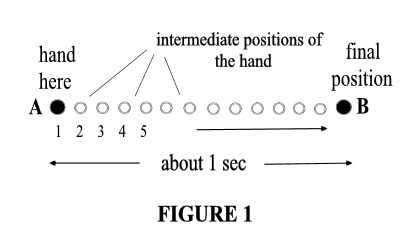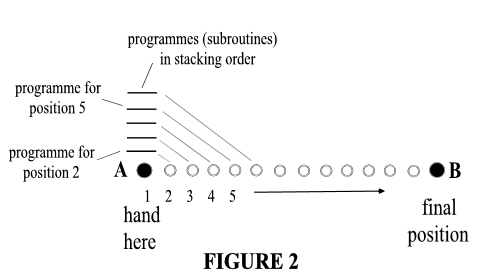LEARNING PATTERN
MECHANISM
IN SKILLS
(April, 2007)
N.
Huntley, Ph.D.
By 'learning pattern' we are referring to the informational system and programming involved in physical skills. What is a learning pattern? In a nutshell it is a four-dimensional holographic template that transduces nonlinear energy patterns into linear ones for the execution of skillful movement sequences. The knowledge of the structure of the learning pattern will eventually become an important aspect of scientific theories since the principles involved extend to many other areas of scientific interest.
Owing to the complexity of the mechanism, there will be many interpretations or ways of describing it, including using analogies. In this article we shall mainly focus on the holographic features as it functions in time. The following is a relatively simple illustration of how this property works.
Figure 1 merely shows the movement of the hand (any complex motion or just straight) from A to B. This is representative of any sequence of movements that the body might make, for example, golf swing, tennis stroke. Let us consider there are a thousand separated identifiable positions of the hand between A and B, and the complete movement takes about one second. This is roughly the average span in time for a completed learning pattern (it will vary with level of skill), as observed directly by introspection.

To explain the property of the learning pattern regarding its holographic aspect in time (as well as space), we must consider a completed learning pattern template. That is, the movement has been learned from A to B (if it is a simple straight movement then anyone has already learned this without any specific practice required for this test).
If one now studies Figure 2, one sees it is showing that the programme for the different positions of the hand into the future, for one second, are in stacking order when the hand is in position 1. This means when the hand is at A, in position 1 (but intending to move to B), it not only has the programmed coordinates for position 1 but all the future ones, in order, first to last. In this example, it means a thousand separate pieces of information corresponding to the positions between A and B are evident within the kinaesthetic sense at A, sensed in the muscular tensions acting in the margin of consciousness. However, all these coordinate frames are perceived as one whole, and instantaneously---this is a holographic structure.

Strictly speaking it is not quite as simple as this since, for example, these future positions, such as the final one at B, are actually whole quantum states---from the beginning to the respective separate positions---which mould the motion, pulling it to the position at B. They are not just final positions. Thus the movement from 1 to 2, or 1 to 3, or 1 to 4, etc. are whole states, and now we see the holographic property more clearly: the whole movement from A to B is within or connected to all the subparts (1 to 5, 1 to 4, etc.) and the initial starting point. Each state only gives a pull towards its own respective position but when they are all superimposed they delineate the precise path learned.
All these frames (1 - 2, 1 - 3, 1- 4, etc.) are sensed kinaesthetically (a sensation seemingly in the muscles) by the individual. This is why miraculous skills can be executed and be controlled at every point in space and time.
This is what holographic means---the whole within each of its sub-parts. As the hand moves to position 2, this position now becomes position 1, the first point, and the final point at B moves ahead one step (if the sequence continues). There is a kind of scrolling motion. Let's use a computer analogy.
Picture a computer screen filled with text. Note that as it scrolls, the top line goes up and disappears. The bottom line, in moving up, has left a space for a new line to appear. This process continues as we scroll.
The harddrive provides the basic total memory storage, but there is a portion (called RAM memory) for the operating system, including our text on the screen for immediate viewing. For our analogy purposes we shall let this temporary memory encompass only the information (text, etc.) on the screen at any one time.
The framework of the screen and its border limitations is the analogy for the learning pattern template. The text may change but the template, or holding frame, remains the same. Similarly the learning pattern template holds programmes. Strictly, although 'template' implies a framework (mould) for holding something, the mind doesn't create empty templates, then fills them with programmes as would be the case with us buying a new computer (hardware) in which to install programmes (software), since in the mind, hardware and software are the same, and this means as information is stored, both the programme and the learning pattern template to hold it develop together. Thus a learning pattern template will have similar programmes with 'fuzzy' margins where inaccurate paths have been stored. Any of the paths though, can be reused by other similar correct or incorrect programmes (and paths) where the paths correspond.
Returning to the computer analogy, as one scrolls down, the harddrive replaces/replenishes the screen with information, resetting the learning pattern template. To improve the analogy we can place just one word on each line so that we have a column of single words which are read vertically by scrolling down---and can also be scanned at a glance into the 'future'.
If we now imagine executing a learned movement of, say, the hand in a complex pattern from A to B, such as, for example, at a keyboard, the positions A to B correspond to the range: first word at the top of the screen going down to the bottom word in the column. Each word itself would correspond to the spatial connections, say, tension in a finger and the wrist at the same time.
We can see the whole column at once, that is, glance ahead of where we are. Thus while the first word is given attention we can see ahead---we know what is coming next. Similarly for the hand in going from A to B.
As one reads down to the next word (second one) one imagines now that scrolling occurs (automatically) by one line. Thus the first word has gone (it does not exist behind/above the screen), and a new word (extra bit of future) appears at the bottom. This continues while the skill sequence is being executed.
Of the 4D holographic template, the template is the framework/boundary of the computer screen. It is constantly replenished by new information (words). This corresponds to the learning pattern resetting itself. The template is 4D since it exists spatially---the hand's position now or the word being read---and also in time, since it encompasses the future positions A to B; compare the screen showing all the words to the bottom of the screen. On the screen, the horizontal dimension---which is one whole word---is 3D space, and the vertical dimension is time.
The 'harddrive' will have some kind of nonlinear storage system utilising extra-dimensional spaces. This information is fed to the 4D holographic learning pattern template which translates it into linearly distributed pulses and patterns. (The book, The Attainment of Superior Physical Abilities gives a little more attention to this; also see other articles on skills for further information.)